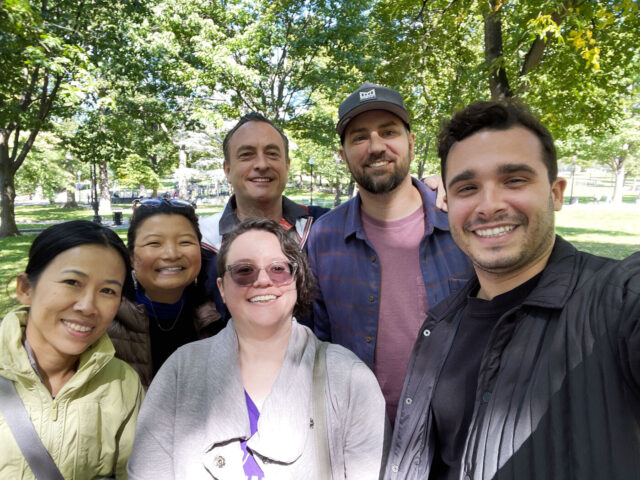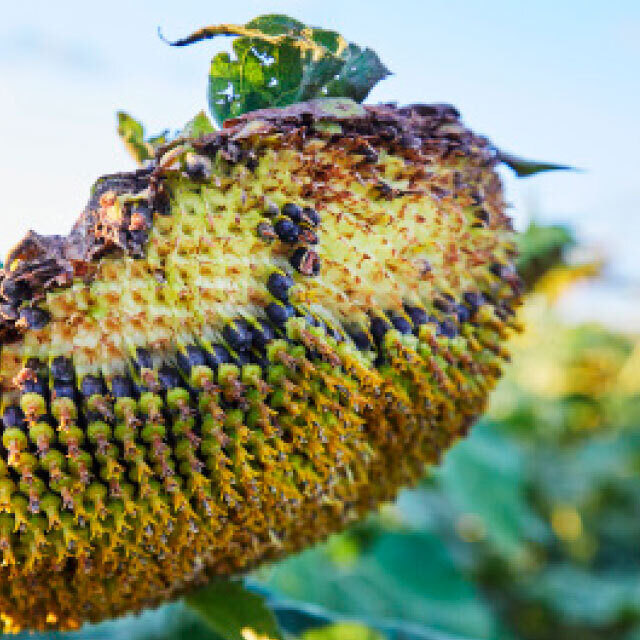
From idea to innovation: Our Innovation Management team tests new technologies in terms of their benefits for KWS.
Innovation Management
The team for inspiring ideas
New technologies, new business models and new solutions for agriculture? That’s the role of our global Innovation Management team: Its seven members are always on the lookout for new ideas.
A laser scarecrow to protect sunflowers from bird damage? Melvin Huber from our Innovation Management team got this idea from aviation: A beam of light keeps birds away from landing and nesting on airports – so why not see if it wards off birds from our sunflowers? After a year of research, the team leased some fields in North Dakota in May 2023, sowed sunflower and set up the laser. Its beam tirelessly traverses the field all day long. And with success: An installed wildlife camera shows that the same animals did not return to the field after coming into contact with the light beam. The difference was particularly evident in comparison to the control field: There was 62 percent less bird damage on the field with the laser. In this way, the team was able to protect our sunflowers without the need for pesticides.
Modern scarecrow: A green laser beam travels across a field of sunflowers and repels birds effectively.
To come up with ideas like this, the Innovation Management team regularly puts its heads together and researches the latest technologies and trends from all industries that we can potentially take advantage of for our work at KWS. Formerly known as the Digital Innovation Accelerator (DIA), the team has not only had a new name since the beginning of 2024, but also an additional function as part of our strategy: While it previously only investigated new business models bound by digital solutions, they are now able to look beyond digital technologies. Starting out as Project D (for digitalization) following an initiative by our Chief Financial Officer, Eva Kienle, the team has now grown to seven members spread across the U.S. and Germany.
“There are lots of ideas
with fantastic potential.”
Meredith Mendola
With Microsoft and Start-ups
Backed by their wide-ranging expertise, they work with established companies such as Microsoft, but also support promising start-ups. “That’s a great opportunity to get out of a silo mentality,” states Meredith Mendola, Operations Lead, who has been with the team since its inception. “There are lots of ideas with fantastic potential we might not yet know about. We can acquire valuable knowledge for KWS through our close collaboration with start-ups, universities, and other external organizations.”
Ideas can come from the team itself, but also from colleagues around the world. If a colleague asks the team for a soil sensor, for example, that sets the process in motion: The members look at whether the proposal has a benefit for KWS, what risks it harbors, and whether it fits in with our strategic objectives.
Then the scouting phase begins, in which the team starts to get an overview of the current state through networks, research and collaboration with external experts. They have a dedicated Technology Scout, Marina Shimono, who drives the search and evaluation of companies.
Once the technological roadmap has been finalized, the team sets up a pilot project, either through collaboration with an established company or a start-up, and sometimes by purchasing the solution if it’s available off-the-shelf. Finally, an assessment is made if the solution was viable and can be scaled further internally, or whether the team wants to change their hypotheses based on their learning and experiment again. “Some ideas and implementations work perfectly, but with others we realize that the concept doesn’t always shape up,” says Meredith Mendola. “Then we learn from that experience and do things differently next time.”

With laser scarecrow

Without laser scarecrow
This article is from insideKWS, the employee magazine of KWS. If you are an employee of our company, you have access to all other articles and previous issues. |
Dieser Artikel stammt aus der KWSintern, dem Mitarbeitermagazin der KWS. Wenn Sie Mitarbeiterin oder Mitarbeiter unseres Unternehmens sind, haben Sie Zugriff auf alle weiteren Artikel und auf frühere Ausgaben. |
© KWS SAAT SE & Co. KGaA 2025